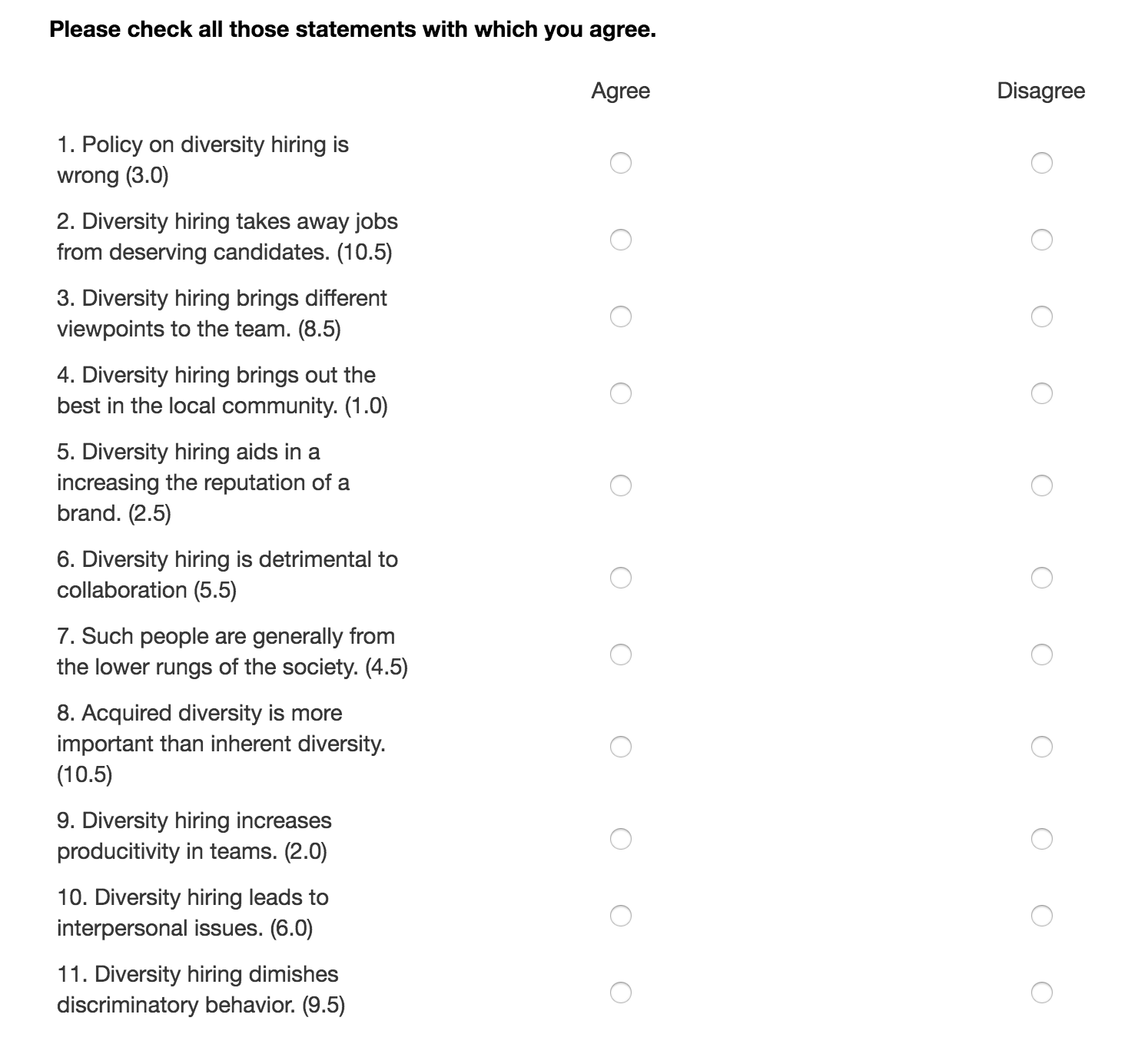
Thurstone Scale: Definition
Thurstone scale is defined as a unidimensional scale that is used to track respondent’s behavior, attitude or feeling towards a subject. This scale consists of statements about a particular issue or topic where each statement has a numerical value that indicates the respondents attitude towards the topic as favorable or unfavorable. Respondents indicate the statements that they agree with, and an average is computed. A mean score of the agreements or disagreements is calculated as the attitude of the respondent towards the topic.
LEARN ABOUT: Average Order Value
This scale was developed by Robert Thurstone to approximate measurement in equal-appearing interval levels. The Thurstone scale is built upon the fundamentals of the Likert scale, but this method of constructing an attitude scale not only takes value of each item of into consideration while evaluating the final attitude score but also caters to neutral items. The Guttman scale and the Bogardus social distance scale are also variations of unidimensional scales where elements can be ordered in a hierarchical manner.
There are three scales while talking about the Thurstone scale question but the most commonly used method is the equal appearing intervals and hence the scale is also called the equal-appearing interval scale. The two other are slightly more complex to develop but still result in the same agree/disagree quiz question type; they are the method of successive intervals and the method of paired comparisons.
LEARN ABOUT: System Usability Scale
How to conduct a Thurstone Scale Survey with an Example
An example of a Thurstone scale survey is to understand the attitude of employees in an organization towards diversity hiring in that organization. There are 2 distinct milestones in the Thurstone scale question; to derive the final questions and administer the Thurstone scale question and conduct its analysis.
Derive the Final Question
There are 5 distinctive steps to derive the final question. They are:
- Step 1 – Develop statements: Develop a large number of agree/disagree statements on a certain topic. For example, if you wanted to find out people’s attitudes towards the policy of diversity hiring in an organization, your statements may include:
- Policy on diversity hiring is wrong.
- Diversity hiring takes away jobs from deserving candidates.
- Diversity hiring brings different viewpoints to the team.
- Diversity hiring brings out the best in the local community.
- Diversity hiring aids in increasing the reputation of a brand.
- Step 2 – Rank each statement with a panel of judges: The next step would be to have a panel of judges rate each item on a scale of 1 to 11 where 1 is the least favorable attitude towards the common vector – diversity hiring and 11 is an extremely favorable attitude. It is important to note that the judges are required to rate each option and not agree or disagree with them.
- Step 3 – Calculate median and/or mean and Interquartile range (IQR): The data collected from all judges is to then be analyzed to draw up a table with the mean or median values in the ascending order. Using median or mean is a personal choice and the options throw up accurate results in the use of either. If you have 50 statements, you need to have 50 means/medians and 50 IQR’s.
- Step 4 – Sorting the table: The data has to be sorted on the basis of smallest to largest median/mean and the IQR’s for each median/mean have to be in a descending order. This can be represented as:
Statement Median or Mean IQR 43 1 1.25 21 1 1 16 1.5 1 3 3 2 6 5 2 28 6 1 37 7 3 9 7.5 1.5 18 9 2 26 11 2 - Step 5 – Selecting final variables or options: Select options on the basis of the above table. For example, you could select one item from each mean/median value. You want the statements with the most agreement between judges. For each median value, this is the item with the lowest interquartile range. This is a “Rule of Thumb”: you don’t have to choose this item. If you decide it’s poorly worded or ambiguous, choose the item above it (with the next lowest IQR).
Administering and Analysis of the Thurstone Scale Question
Once the final questions have been decided upon, they are shared with the respondents to select from agreement or disagreement. The ratings are shown in parenthesis but the rating is not shared with the actual respondents.
- Administering and analysis by median or mean: The question and the subsequent options can be administered to the respondents by using either the mean or the median score in the below format. The weights of the statements are summed and divided by the number of statements checked. If a respondent were to agree with statements 2, 5, 7 and 10; the attitude score is 10.5 + 2.5 + 4.5 + 6.0 = 23.5/4 = 5.8. Dividing the number of statements puts this score at a little above the midway point of the 1-11 scale. This score indicates that the attitude is slightly favorable to diversity hiring in the organization.
- Administering and analysis by simple count or percentage: In the same example above, if the question is administered without the mean or median score, the calculation can be depicted by a simple count of agreement on the 1-11 scale or a percentage. If the respondent were to agree with statements 1, 4, 5, 6, 8, 9 and 11; the agreement count is 7 out of 11 which puts the percentage at 63.63% which means that the attitude is favorable towards diversity hiring.
Characteristics of a Thurstone Scale Question
Some distinct characteristics of a Thurstone scale question are:
- They are two stepped: A Thurstone scale question is never administered at the first iteration stage without the rating by judges. This is an important characteristic of this question as the options that a respondent sees are weighted and there is consensus of them being in the survey.
- Mean or median is always calculated: Since each option is weighted, the mean or median is calculated for each option. This also forms the basis of the selection method for use in the final survey.
- Only agree or disagree options: The respondent makes a selection only on the basis of the agreement or disagreement with the statement.
Use of a Thurstone Scale Survey
The Thurstone scale survey is used to measure the respondents attitudes on a particular subject. The scale can be applied to a wide range of market research surveys, in market research including:
- Surveys that measure opinions: The Thurstone scale question produces quantifiable data about the measures of strength of the respondents opinions.
- Those that gauge attitudes or feelings: This scale is used effectively in customer satisfaction to predict future purchasing trends and in employee engagement to calculate turnover.








